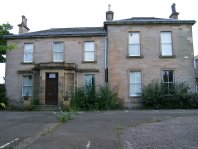
12 Hope Terrace, built for Benjamin Hall Blyth in 1854 - more recently the headquarters of Scottish National Heritage - currently empty following SNH's move to Inverness.
The amount of available information about the people and businesses associated with the West Blacket area varies greatly between streets. This is the result of the compiler of much of the information working first with his own street. It is hoped that coverage will grow as more individuals add information from their own research. Further contributions welcome.
For readers with a specialised interest, much fuller biographical details on most of our 'Notable People' can be found elsewhere. Here we merely supply a summary of their lives and of their West Blacket connections.
Further general information can be found using 'Google', 'Wikipedia' or the sources mentioned in our 'Read It & Research It' section.
3 sources, particularly useful in compiling this section, have been:
Geikie, Sir Archibald |
(1835-1924) Geologist - With a special interest in volcanic geology he became director of the Geological Survey of Scotland in 1867 and held the chair of geology at the University of Edinburgh from 1870 to 1881. In 1882 he moved to London as director-general of the UK Geological Survey. Knighted in 1891, he was President of the Geological Society in 1891-92 and of the Royal Society in 1909. |
16 Duncan Street (now incorporated into Duncan Street dental clinic) was the Geikie family home between c1860 and c1880. Archibald's father, James Geikie, is described in the 1861-62 Post Office Directory as 'Ornamental Hair Manufacturer and Perfumer to the Queen'. Archibald, aged 25, appears under 16 Duncan Street in the 1861 Census, his career as a geologist already established. |
Geikie, James |
(1839-1914) Geologist - James Geikie followed elder brother, Archibald (see above), into the Geological Survey of Scotland. An authority on glacial action, his work The Great Ice Age and its Relation to the Antiquity of Man was published in 1874. Between 1882 and 1914 he succeeded Archibald as Professor of Geology at the University of Edinburgh. |
The 1861 Census entry for 16 Duncan Street shows James Geikie, aged 21, as a clerk in a lawyer's office. The 1871 Census shows him, still at 16 Duncan Street as District Surveyor with the Geological Survey for Scotland. By this time, the father (also James) has given up 'Perfumery' and is listed as a 'Teacher of Music'. |
Nixon, William |
(1810-1848) Architect - Moving from Dublin in 1840, he joined the Office of Works in Edinburgh as Chief Architect, being responsible for the maintenance of Holyroodhouse and many other public buildings. Work in Edinburgh includes interior woodwork in Tolbooth St John's Church (1842), the Police Offices in the High Street (1845) and remodelling of some of the Law Courts in Parliament Square (completed after his early death). |
The Post Office Directory of 1846-47 lists William Nixon as living at 2 Duncan Street with offices in Exchequer Chambers. He died from an abscess in March 1848, probably while still resident in Duncan Street. |
Dallas, Emslie William |
(1809 - 1879) Painter and photographer – Dallas’s early career (1840s-50s) was as a painter, exhibiting at RSA. Works included landscapes and Italian church interiors. By 1860 he had turned to photography and was to operate a succession of New Town studios between 1860 and 1878. He produced ‘cartes de visite’ for Sir James Young Simpson and other notables of the time. |
Post Office Directories and Census Returns show a Dallas family connection with 4 Middleby Street from c1861 to the early 1880s. E W Dallas’s name appears in 1860s directories but by the 1871 census the house is occupied by unmarried Dallas sisters. |
Hudson, Edith |
(c1870 - 19??) Suffragist campaigner - Edith Hudson was prominent in the Scottish suffrage movement of the early 1900s. In 1913, along with Arabella Scott and sisters Agnes and Elizabeth Thomson she was arrested, tried and imprisoned in connection with the attempted arson of a new grandstand at Kelso Racecourse. |
In several 1913 reports on the Kelso ‘Suffragist Outrage’ The Scotsman gives Hudson’s address as ‘Middleby Street’. The Post Office Directory of 1911-12 lists a Mrs Hudson (Edith’s mother?) living at 13 Middleby Street. |
Munro, Archibald |
(c1828 - 1898) Scholar, Teacher and Private School Proprietor – A considerable number of private schools operated in West Blacket in Victorian times. One of the most successful of these appears to have been founded and run by Archibald Munro. An obituary note in The Scotsman of 3rd January 1898 records his popularity and ‘rare ability’ as a teacher. Munro was also an authority on Robert Burns, publishing a book on ‘Highland Mary’ and holding the presidency of Edinburgh Burns Club. |
Archibald Munro opened his ‘Newington Academy’ in October 1852 at 12 Middleby Street (possibly also his home). Later in the 1850s the Munros lived at 3 Middleby Street with the school (by then ‘Newington Institution’) remaining at Number 12. Accommodation for scholars was offered at Number 3 and the 1861 Census lists 8 boy boarders aged from 7 to 16. In 1861 a Scotsman advertisement announces a move for the Institution to ‘New and Commodious School-Rooms’ in the grounds of Claret Hall (off Causewayside, opposite the west end of Duncan Street). This was followed in 1869 by Clarehall Academy at 18 Minto Street (now part of the Minto Hotel). Mr Munro continued to teach at 18 Minto Street until a few years before his death there in 1898. |
Blyth, Benjamin Hall |
(1819 - 1866) Civil Engineer - Benjamin Hall Blyth set up his engineering practice in George Street in 1848, being joined as partner by his younger brother Edward in 1854. B & E Blyth were successful as consulting engineers for many important railway projects. The company founded by Benjamin Hall Blyth still operates from Edinburgh under the name Blyth & Blyth. |
The 1833-34 Post Office Directory lists Blyth's father (Robert, an iron merchant) as living at 26 Minto Street. From the early 1850s Benjamin Hall Blyth, with his practice established at 124 George Street, had become the occupant. Doubtless helped by his professional success, Benjamin was soon to move around 1854 to 12 Hope Terrace, in the then developing Grange district. Overwork contributed to his early death, aged 47. |
 |
12 Hope Terrace, built for Benjamin Hall Blyth in 1854 - more recently the headquarters of Scottish National Heritage - currently empty following SNH's move to Inverness. |
Hardy, Henry |
(1831-1908) Architect - While improvement schemes to Edinburgh's Old Town (George IV Bridge and Johnston Terrace) occupied much of Hardy's early career, from about 1870 churches were to dominate his work. Two of his buildings close to West Blacket are Craigmillar Park Church and much of the former Deaconess Hospital in The Pleasance. |
Henry Hardy lived at 32 Minto Street from c1860 until his death. While his home address remained static he occupied offices in St Andrews Square, in George Street and finally in Hill Street. |
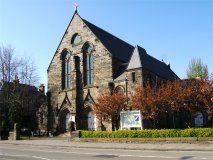 |
Craigmillar Park Church (1878) |
 |
Deaconess Hospital (1894-97) - now NHS Offices. |
Matthew, John F |
(1875 - 1955) Architect - John Fraser Matthew served as apprentice, assistant and office manager to Sir Robert Lorimer before becoming a full partner in the renamed firm of Lorimer & Matthew in 1927. This part of his career was interupted by service in both the Boer War and the 1914-18 War. The 1920s/30s buildings on Edinburgh University's King's Buildings site are among his main works. |
John Matthew lived at 43 Minto Street from c1920 to c1950. His son Sir Robert Matthew was to surpass his father in architectural recognition as Architect to London County Council, Professor of Architecture at Edinburgh University and in establishing the practice of Robert Matthew Johnson Marshall (RMJM). PO Directories suggest that John F Matthew may also have had shorter term connections with nearby 8 West Mayfield c1906 and c1951. (Any information on this would be much appreciated.) |
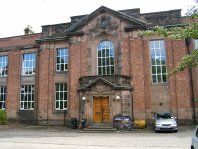 |
Three of John F Matthew's contributions to Edinburgh University's King's Buildings site:
|
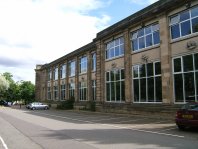 | 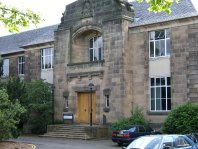 |
Moss, Edward |
(1852-1912) Theatre Manager and Owner - Horace Edward Moss, founder of the Moss Empire chain of theatres was himself the son of a theatre manager. He 'served his apprenticeship' at a theatre run by his father in Greenock. In 1877 he came to Edinburgh, leasing the Gaiety Theatre in Chambers Street (on the site now occupied by Edinburgh University's Adam House examination hall). His chain of theatres began to grow and from 1892 included what is now Edinburgh's Festival Theatre. His 'Empire' grew to over 30 theatres, countrywide, including The London Palladium. |
Edward Moss lived at 8 Minto Street during at least part of his time in Edinburgh as he is recorded there in the 1881 Census and in the 1883-84 Post Office Directory. He maintained a Lothian connection through ownership of Middleton Hall, Gorebridge, where he died in late 1912. He was buried in Portobello Cemetery. |
Munro, Archibald |
(c1828 - 1898) Scholar, Teacher and Private School Proprietor – See Middleby Street for fuller information. |
The final location for Mr Munro's school (then named Clarehall Academy) was 18 Minto Street (now part of the Minto Hotel). He died there a few years after retiral. |
Spittal, Sir James |
(1769 - 1842) Lord Provost of Edinburgh – Following the Burgh Reform Act of 1833 James Spittal, a silk merchant with premises on South Bridge, became the first Lord Provost of Edinburgh to be elected by a free vote. He served as Provost from 1833-1837. Spittal Street, joining Bread Street to Johnstone Terrace, dates from 1835 and commemorates his tenure. |
James Spittal was living at 3 Minto Street at least from 1831. 1832 must have been an eventful year at Number 3 with the marriage of a daughter from his first marriage and the birth of a son to his second wife. Lady Spittal continued to live at 3 Minto Street until the mid 1850s. The house has a large stained glass window bearing Sir James's arms. The ceremonial lamp posts marking his provostship survived until 1935. |
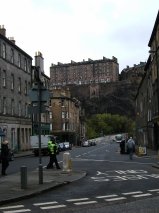 |
The view along Spittal Street towards Edinburgh Castle. |
Steell, Gourlay |
(1819 -1894) Artist - Gourlay Steell was born in Edinburgh, son of John Steell (a noted woodcarver) and Margaret Gourlay. Like his father and elder brother, John Steell (sculptor of many of Edinburgh's prominent monuments), he was to follow an artistic career. Specialising in animal studies he exhibited regularly at the Royal Scottish Academy, being elected ARSA in 1846 and RSA in 1859. His work found favour with Queen Victoria and he followed Edwin Landseer as her animal painter for Scotland. In 1882 he succeeded William Fettes Douglas as curator of the National Gallery of Scotland. |
Gourlay Steell lived at 23a Minto Street during the latter years of his life, dying there in 1894. |
Usher, John |
(1828 - 1904) Distiller and Benefactor - John Usher was the fourth and youngest son of Andrew Usher an Edinburgh spirit merchant. Having set up his two eldest sons as brewers, Andrew (senior) in partnership with younger sons, Andrew and John, actively pursued his whisky interests. Andrew Usher & Co were prominent in introducing vatted and blended whiskies, hence improving the quality and variety of Scotch Whisky and paving the way for its penetration into English and overseas markets. In 1859 Ushers acquired the 'Glen Sciennes' malt whisky distillery, renaming it 'Edinburgh Distillery'. |
John Usher lived at 13 Minto Street during much of the 1860s. Minto Street was close to the Ushers' offices in West Nicholson Street, the Sciennes Distillery and its granaries and maltings at Saint Leonards. 'For Sale' notices in the Scotsman for early 1870 offer 13 Minto Street and encourage applications to 'John Usher, 26 West Nicolson Street'. In 1883 John Usher bought the mansion house, Norton House near Ratho (now an hotel). In 1899 he became a baronet, taking the title Sir John Usher of Norton and Wells. He died in Cairo in 1904, having travelled there seeking to recover his health. |
|
While Andrew Usher (junior) is remembered through his donation of £100,000 to the City of Edinburgh for the building of the concert hall that bears his name, John's donations to the University of Edinburgh were also notable. The 'Alexander Bruce and John Usher Chair of Public Health' (one of the first of its kind in Britain) was established in 1898 and 1902 saw the opening of the 'John Usher Institute of Public Health'. |
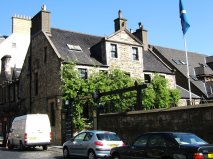 |
Pear Tree House in West Nicolson St - family home of the Ushers and offices for their distilling business - now a popular pub. |
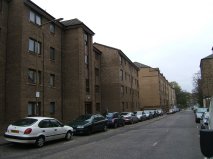 |
Little sign of a distillery in Sciennes now, but this was the site of the Ushers' Edinburgh Distillery. |
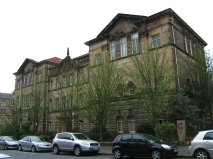 |
John Usher's gift to the City and University - the Usher Institute of Public Health in Warrender Park - now converted to student accommodation. |
Walls, William |
(1860 - 1942) Artist - During study in Antwerp, Walls developed his skills in drawing and painting zoo animals such as lions and leopards. This interest continued on his return to Scotland where he was one of the founders of Edinburgh Zoo. As well as animal studies in oil and watercolour He also painted landscapes. He was elected ARSA in 1901 and RSA in 1914. |
Around 1913/14, Walls was living at 23a Minto Street the house occupied 20 years or so earlier by another animal painter, Gourlay Steell. |
Balmain, James |
(1853 - 1937) Photographer – Born in Philadelphia, USA, of Scottish parents, Balmain came to Edinburgh and worked for James Tunny (see below) as a vitro enameller. Following Tunny’s death (in 1887) Balmain continued the business, eventually under his own name. Many Balmain images appear in Yerbury – A Photographic Collection 1850-1993 by Malcolm Cant, Mercat Press, Edinburgh 1993 and on Edinburgh Central Library’s photographic website – http://www.capitalcollections.org.uk |
The 1881 census shows Balmain living with James Tunny and family at what is now 21 Salisbury Place. By 1901 this had become Balmain’s home and he was operating studios next door at 19 Salisbury Place and also in Shandwick Place. |
McCrie, Dr Thomas |
(1772 - 1835) Secession Minister and Church Historian – Ejected from his charge in 1809, McCrie set up his own church, first in Carubber’s Close and from 1813 in Davie Street, where he was to preach for the rest of his life. His most noted work, A Life of John Knox, was published in 1812. |
McCrie lived in Salisbury Place from 1822 until his death. On Leslie’s map of that period the title ‘Revd Dr Macree’ appears close to the southern corner of Salisbury Place and Minto Street. The 1841 Census Returns list Mary McCrie (his widow?) living at 13 Salisbury Place. |
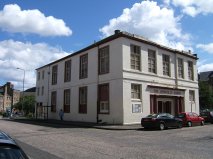 |
Now 'The Apostolic Church' in Davie Street. Almost certainly the site of McCrie's church and possibly the original building. Can anyone confirm? |
Tunny, James |
(1820 - 1887) Photographer and Calotypist – James Good Tunny was the son of a Causewayside handloom weaver. He turnedfrom his original trade of shoemaking to the emerging art of photography in 1851. His earliest studio was in South Clerk Street. Examples of his work, including views of Grange Loan and Causewayside, appear in Yerbury – A Photographic Collection 1850-1993 by Malcolm Cant, Mercat Press, Edinburgh 1993 and on Edinburgh Central Library’s photographic website – http://www.capitalcollections.org.uk |
Tunny moved to what is now 21 Salisbury Place c1870, both business and house being eventually taken up by James Balmain (see above). (Here is a link to details of a recently published book 'A Study of James G Tunny' by Julian Bukits which provides considerable detail, not only of Tunny's career as an accomplished and innovative photographer, but also of his family and political life.) |
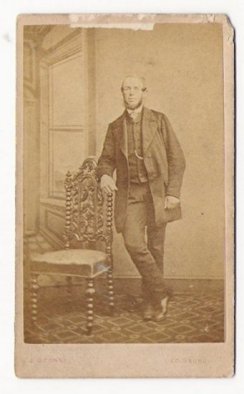 |
A 'carte de visite' from James Tunny's studio at 93 Princess Street (occupied 1860-1874) - subject unknown - date, post 1862). |
Bow, Robert |
(1832-1908) Civil Engineer – A notable contributor to the theory of structures such as railway bridges, Bow wrote two texts in this area. He also wrote papers on optics, lecturing regularly to the Edinburgh Photographic Society. He was elected FRSE in 1869. |
Robert H Bow came to 7 South Gray Street with his widowed mother around 1850 and lived there for the remainder of his life. A bachelor; he seems to have lived in considerable style, with census returns always listing from one to three live-in servants. He is buried in Grange Cemetery. |
Johnston, W Miles |
(1893 - 1974) Artist and Teacher – As well as his paintings, Johnston’s work includes animal decorations on pottery and heraldic work in Sir Robert Lorimer’s Scottish National War Memorial. He taught at John Watson’s College (the building now occupied by the Scottish National Gallery of Modern Art). |
Post Office directories list Johnston as occupying 5 South Gray Street from c1930. From the 1940s, he and Dorothy Nesbitt (see below), his wife, spent much of their time in Kirkcudbright where they were prominent members of its thriving artistic community. Their gallery/shop in Kirkcudbright was called ‘The Crafts’ (the same name that appears by the gate of 5 South Gray Street). |
Nesbitt, Dorothy |
(1895 - 1971) Artist and Teacher – Dorothy Nesbitt trained at Edinburgh College of Art and painted landscapes in oil and watercolour. She married W Miles Johnston (see above). Both were active in Kirkcudbright’s artistic community, Dorothy being prominent in saving Harbour Cottage as an art gallery. |
Dorothy Nesbitt, presumably while living at 5 South Gray Street, taught at St Trinnean’s School, then occupying nearby St Leonard’s (now part of Edinburgh University’s Pollock Hall complex). The Johnston daughters were pupils there. A wartime visitor to their Kirkcudbright home was a young serviceman and budding cartoonist, Ronald Searle. After considerable ‘artistic license’ and some tinkering with their school name ‘The Belles of St Trinian’s’ were born. |
Sturrock, Alex |
(1885 - 1953) Artist - Alick Sturrock was born in Edinburgh where he attended classes at the College of Art. He married Mary Newbery (see below) in 1918. Mainly a landscape painter, he was elected RSA in 1937 and served as the Academy’s Treasurer, 1938-47. |
The Sturrocks moved to 13 South Gray Street around 1945. |
Sturrock, Mary |
(1892 – 1985) Artist - Mary was the daughter of Francis (Fra) Newbery, director of Glasgow College of Art, and Jessie Newbery, a talented designer and teacher of needlework at the college. Newbery’s tenure as director saw the building of a new college to the design of Charles Rennie Mackintosh. Mary, an accomplished flower painter, became a close friend of the Mackintoshes. She married fellow artist Alick Sturrock (see above) in 1918. |
13 South Gray Street became the Sturrocks’ home around 1945. with Mary living there until 1985. |
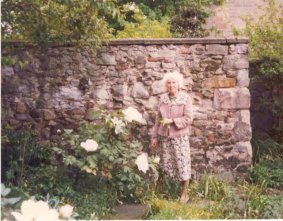 |
Mary Sturrock in her South Gray Street garden. Photographed between 1975 and 1980 by the late Dr R S ('Dick') Swain of 8 South Gray Street. |
Wigham, Eliza |
(1820 - 1899) Social campaigner and philanthropist - Eliza Wigham was prominent in many campaigns for social improvement including the American anti-slavery movement, the women’s suffrage cause, improved medical treatment for women and the admission of women into schools of medicine. Closer to home, she was a dedicated supporter of missionary efforts in nearby Causewayside. |
Eliza’s father was a shawl maker with premises in Sciennes and Leslie’s 1826 map shows another ‘Mr Wigham’ (her father's cousin?) resident in Salisbury Road. Post Office Directories from at least 1836-37 list ‘John Wigham, shawl manufacturer’ at 5 South Gray Street. This house remained Eliza’s home until the late 1890s when, in ill health, she went to live with her sister in Dublin. |
Knott, Cargill G |
(1856 - 1922) Physicist and Mathematician – Born in Penicuik, Knott studied and researched at Edinburgh University from 1872 until 1883 when he was appointed Professor of Physics in the Imperial University of Japan. From that time he became prominent in establishing the science of seismology. In 1891 he returned to Edinburgh as Lecturer and later Reader in Applied Mathematics. He was a founder of the Edinburgh Mathematical Society and General Secretary of the Royal Society of Edinburgh. He was awarded an honorary LL.D. by St Andrew’s University and was elected FRS in 1920. |
Dr Knott lived at 42 Upper Gray Street from c1895 until his very sudden death in 1922. The 1901 census lists Cargill and Mary Knott with 3 daughters, the eldest, Ellen, being born in Japan. |
MacDonald, John Blake |
(1829-1901) Painter – Born in Morayshire, MacDonald was noted for landscapes and for Scottish history painting. Appropriate to his interests and to his family name, his diploma work on election to full membership of the Royal Scottish Academy in 1877 was 'Glencoe, 1692' (a powerful commemoration of the MacDonald massacre). |
John Blake MacDonald was living at 7 Upper Gray Street c1886/87. He may have been the last occupant of the original house before the building of St Columba’s Church on the site in 1888/89. |
Morham, Robert |
(1839 -1912) Architect - As City Architect Morham was responsible for many buildings around Edinburgh including police stations, swimming baths, the Central Fire Station (Lauriston Place), and the City Hospital (Greenbank). The closest work of his to West Blacket as City Architect is the former police station on the junction of Causewayside and Sciennes House Place. |
Morham lived for a short time c1876 at 5 (now 9) Upper Gray Street, the original house that preceeded St Columba's Church House. He was architect of the tenement block on the opposite side of the street, built around 1880 for the Stratton family. |
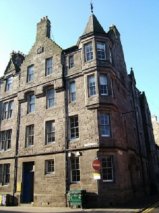 |
3 buildings by Robert Morham:
|
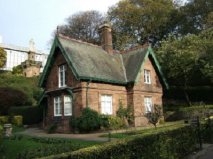 | 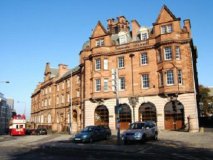 |
Saxby, Jessie M E |
(1842 - 1940) Author - Jessie Saxby was born in Unst, Shetland. Her father, Laurence Edmonston, and husband, Henry Saxby, were both noted ornithologists. When widowed, aged 32, she moved from Inveraray to Edinburgh with her young family. In 1898 she returned to Unst, living there for the remainder of her long life. She was the author of more than 30 books of folklore, travels and boys adventure stories. |
The 1881 Census lists Jessie Saxby (profession - authoress) living at 10 (now 21) Upper Gray Street with her four young sons, aged 14 to 7. The third of these sons, Horace (aged 10 while in Upper Gray Street in 1881), seems to have been inspired by mother's adventure stories, serving first with the Canadian Mounted Police, then in the Boer War, and finally with the South African Mounted Constabulary. |
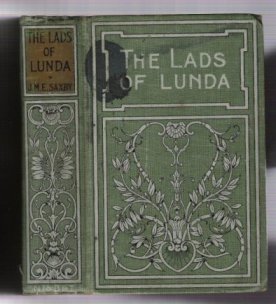
| From the 7th Edition of one of Jessie Saxby's adventure books for boys. Probably first published c1887, it contains a dedication in verse to her son Horace (see above) who apparently was already (aged 16?) 'revelling in a freedom far apart ....... upon that prairie-wild'. |
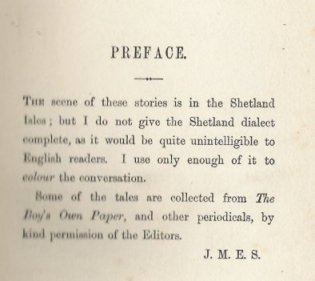 |
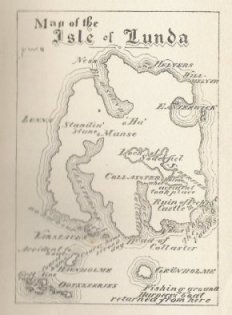 |
Stanton, George Clark |
(1832 - 1894) Sculptor and painter - Born in Birmingham, and after study there, he joined Elkington, the noted firm of art metalworkers. When sent by his employers to Florence for further study he joined Garibaldi's Red Shirts. While in Florence he also found time to fall in love with Clara Gamgee, from Edinburgh. After settling with Clara in Edinburgh, Clark Stanton followed a varied artistic career as sculptor (statues, busts and reliefs), water colour artist (historic and literary subjects) and teacher at the RSA's Life Schools. He was elected ARSA in 1862 and RSA in 1885. |
Clark Stanton lived at 24 (now 38) Upper Gray Street in the late 1860s and early 1870s. His studio was in Ramsay Lane, close to the castle. His most easily observed work is in Parliament Square, in front of St Giles, on the monument to the 5th Duke of Buccleuch. He sculpted a set of 6 reliefs around the plinth of the monument to illustrate episodes from the Buccleuch family history. Stanton's signature can still be made out on these. He also sculpted one of the secondary groups round the statue of Prince Albert in Charlotte Square and a number of the smaller stone figures on the Scott Monument. |
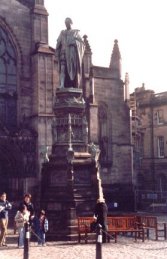 |
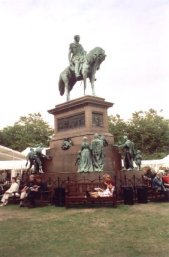 |
The Buccleuch monument, Parliament Square. below - one of Stanton's 6 reliefs on plinth. |
The Albert Monument, Charlotte Square. below - one of the 4 corner groups round base is by Stanton (possibly this one). |
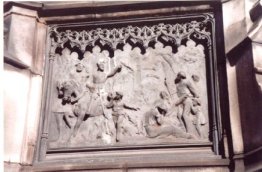 |
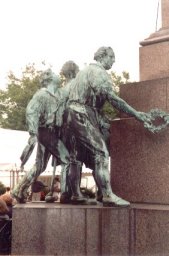 |
|
Sorry, no information for West Mayfield at present. Suggestions and contributions welcome. |